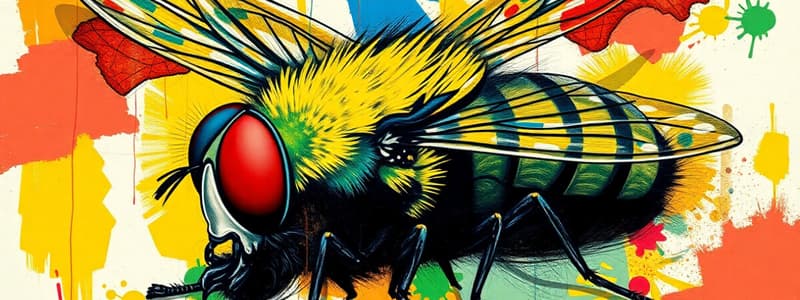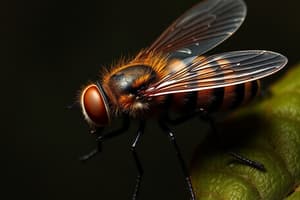Podcast
Questions and Answers
What is the primary mechanism that horn flies use to feed on their hosts?
What is the primary mechanism that horn flies use to feed on their hosts?
- Proboscis for blood taking (correct)
- Chewing mouthparts
- Piercing mouthparts
- Fleshy, sponging mouthparts
What is a characteristic of the life cycle of Haematobia irritans?
What is a characteristic of the life cycle of Haematobia irritans?
- They remain on hosts except during egg-laying (correct)
- Females lay eggs in rotting organic material
- Pupae do not undergo overwintering
- Adults frequently leave hosts to find mating partners
Which of the following statements accurately describes a consequence of horn fly infestations?
Which of the following statements accurately describes a consequence of horn fly infestations?
- They are known to cause minimal irritation to cattle.
- A large number of flies can result in significant economic losses. (correct)
- They do not transmit any diseases to cattle.
- They can lead to increased milk production in dairy cattle.
Which method is NOT recommended for the control of horn flies?
Which method is NOT recommended for the control of horn flies?
How can the horn fly be distinguished from the stable fly based on size?
How can the horn fly be distinguished from the stable fly based on size?
What is the primary mechanism through which blood-feeding insects irritate their hosts?
What is the primary mechanism through which blood-feeding insects irritate their hosts?
What is the correct sequence in the life cycle of Diptera?
What is the correct sequence in the life cycle of Diptera?
What is a significant concern related to the disease transmission by Stomoxys calcitrans?
What is a significant concern related to the disease transmission by Stomoxys calcitrans?
Which of the following best describes a method of pest control for managing flying insect pests?
Which of the following best describes a method of pest control for managing flying insect pests?
What morphological feature is essential for insect identification?
What morphological feature is essential for insect identification?
Which of the following types of lice primarily causes anemia in hosts?
Which of the following types of lice primarily causes anemia in hosts?
Which life cycle stage do fleas undergo that is distinct from the life cycle of flies?
Which life cycle stage do fleas undergo that is distinct from the life cycle of flies?
What is characteristic of the mouthparts of Stomoxys calcitrans?
What is characteristic of the mouthparts of Stomoxys calcitrans?
How long does it take Stomoxys calcitrans to complete its blood meal?
How long does it take Stomoxys calcitrans to complete its blood meal?
Which life cycle characteristic is true for Musca domestica?
Which life cycle characteristic is true for Musca domestica?
Musca autumnalis is primarily identified by feeding on which of the following?
Musca autumnalis is primarily identified by feeding on which of the following?
What diseases can Stomoxys calcitrans potentially transmit?
What diseases can Stomoxys calcitrans potentially transmit?
How do you identify Musca domestica based on physical characteristics?
How do you identify Musca domestica based on physical characteristics?
What impact does Musca autumnalis have on livestock performance?
What impact does Musca autumnalis have on livestock performance?
Which of the following is a life stage associated with the typical muscid life cycle?
Which of the following is a life stage associated with the typical muscid life cycle?
What type of disease vector is Musca autumnalis characterized as?
What type of disease vector is Musca autumnalis characterized as?
Flashcards are hidden until you start studying
Study Notes
Insects: Flies (Diptera)
- Flies have three pairs of legs
- There are three main body segments: head, thorax, and abdomen
- Flies have antennae
- Their life cycle consists of four stages: Egg, Larva, Pupa, Adult
- They are biologically and mechanically important in veterinary medicine since they can transmit diseases
- Can cause fly worries, or irritation, as well as fly strikes (myiasis)
Stomoxys calcitrans (Stable fly)
- A type of blood-sucking muscid fly
- Is similar to house fly but has rigid, conspicuous, and forward projecting mouthparts
- Can sit on walls with its head up
- Females lay eggs on decaying matter such as damp hay
- Requires 3 minutes to finish its blood meal
- Can attack animals, transmit disease organisms, and increases head, ear movement, skin twitches, and tail swishes in infested animals
Musca domestica (House fly)
- Can grow up to 7.5 mm long
- Has fleshy mouthparts adapted to sponging
- Has sticky hairs on the pads of their legs
- This fly is light to dark grey
- Lay their eggs in a wide variety of decaying organic substrates
- The life cycle of this fly is typical of a muscid fly
- This type of fly is a common sight and can be found in both animal enclosures and within human homes
Musca autumnalis (Face fly)
- Often mistaken for the common house fly
- Lay eggs in feces or rotting organic material
- Annoyance to animals, causes eye disorders, or conjunctivitis
- Typically found on animal secretions and wounds
- Can be a significant nuisance in agriculture as they hinder grazing
- Can transmit viruses, bacteria, helminths, and protozoa
- Is a biological vector of Habronema and Draschia megastoma
Haematobia irritans (Horn fly)
- The smallest known bloodsucking muscid fly
- Can grow up to 4 mm long
- Can be distinguished from the stable fly by its size, being half the size, and its shorter proboscis.
- Feeds on cattle and can be a concern for farmers because it can reduce milk production and weight gain in cattle
- When not feeding, these flies tend to cluster around the horns of cattle
- Flies can be found on the back and belly of cattle, though they are typically found on the back
- Females lay eggs in fresh cattle feces
- Can transmit cattle helminths
- Can cause irritation, resulting in an economic impact if there are over 200 flies on the animal
Culicoides spp. (Midge)
- These flies are part of the Ceratopogonidae family
Treatment and prevention of fly issues
- Use screens to deter flies from entering enclosures
- Effective sanitation practices are important in controlling flies
- Do not treat compost.
Key Facts
- Horn fly (Haematobia irritans) is host specific, feeding only on cattle
- Horn flies remain on their host, except when females lay eggs in fresh cattle feces
- Stable fly (Stomoxys calcitrans) requires a 3-minute feeding time for blood meals
- Flies can transmit viruses, bacteria, helminths, and protozoa
- The house fly (Musca domestica) lays eggs in a wide variety of decaying organic substrates
- The Face fly (Musca autumnalis) lays eggs in feces or rotting organic material
- The stable fly (Stomoxys calcitrans) lays eggs in decaying matter like damp hay
- The life cycles of house fly, face fly, and stable fly are all considered "Typical muscid life cycles"
Studying That Suits You
Use AI to generate personalized quizzes and flashcards to suit your learning preferences.




